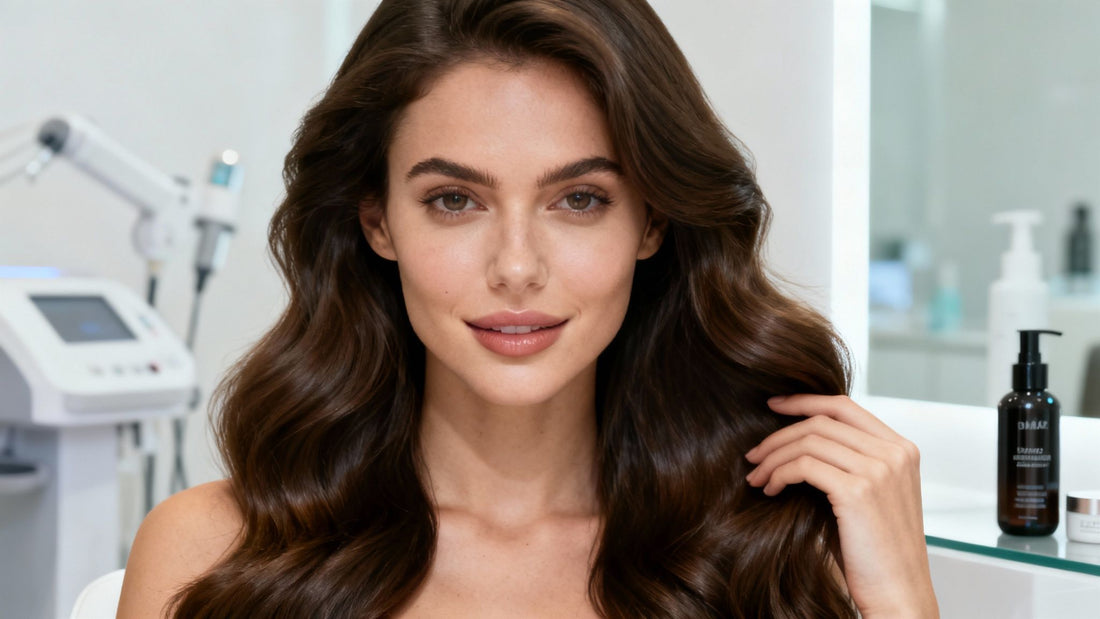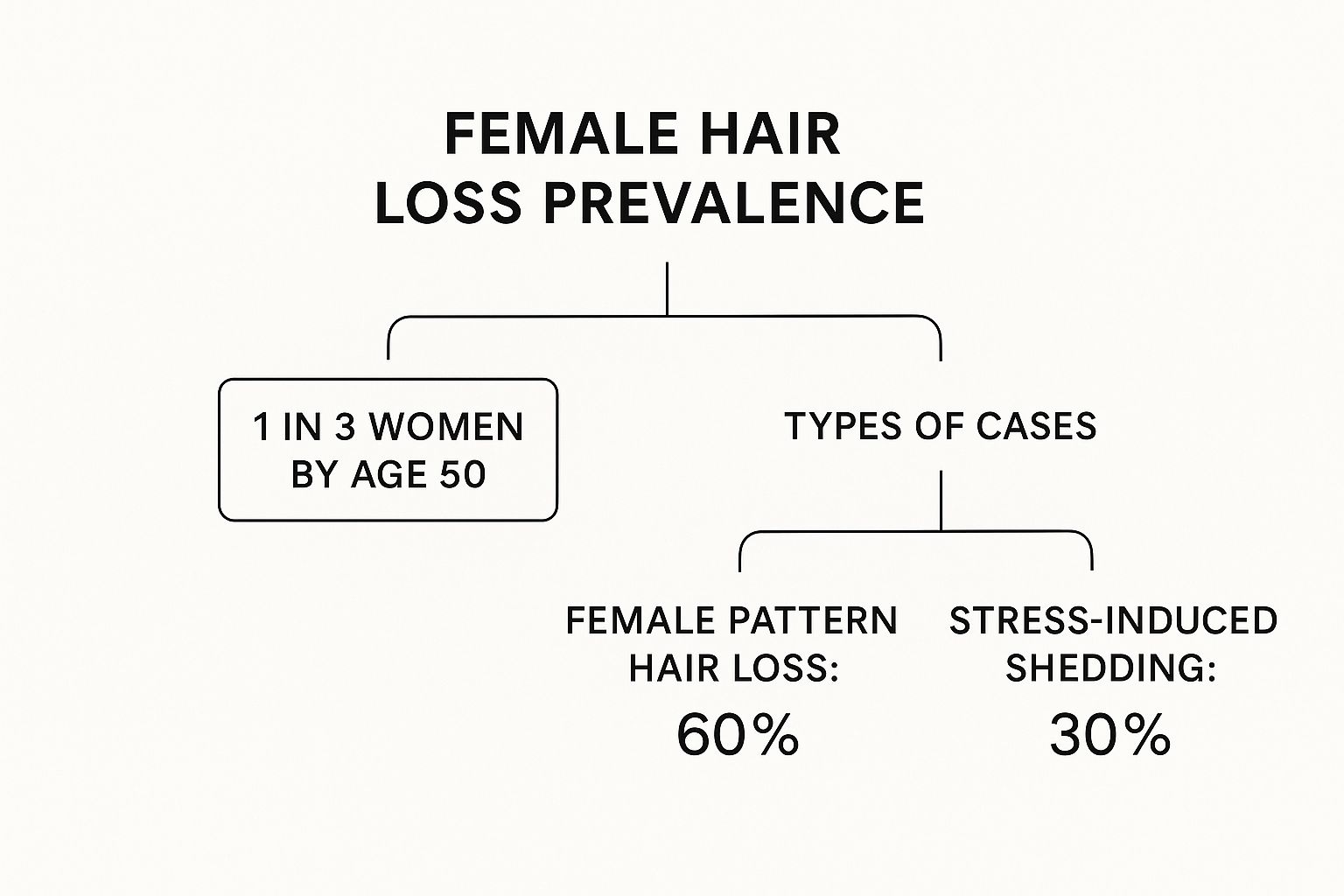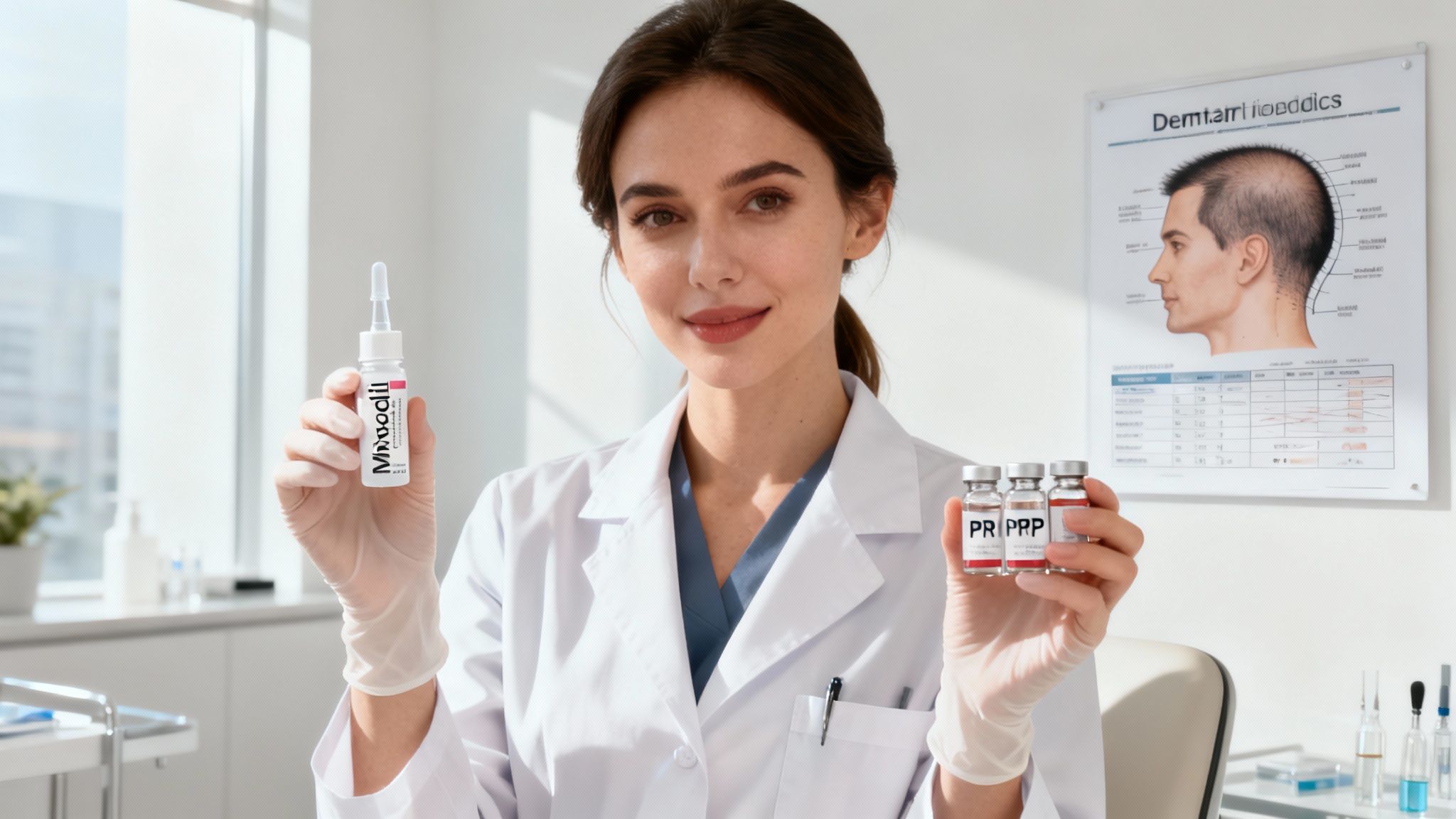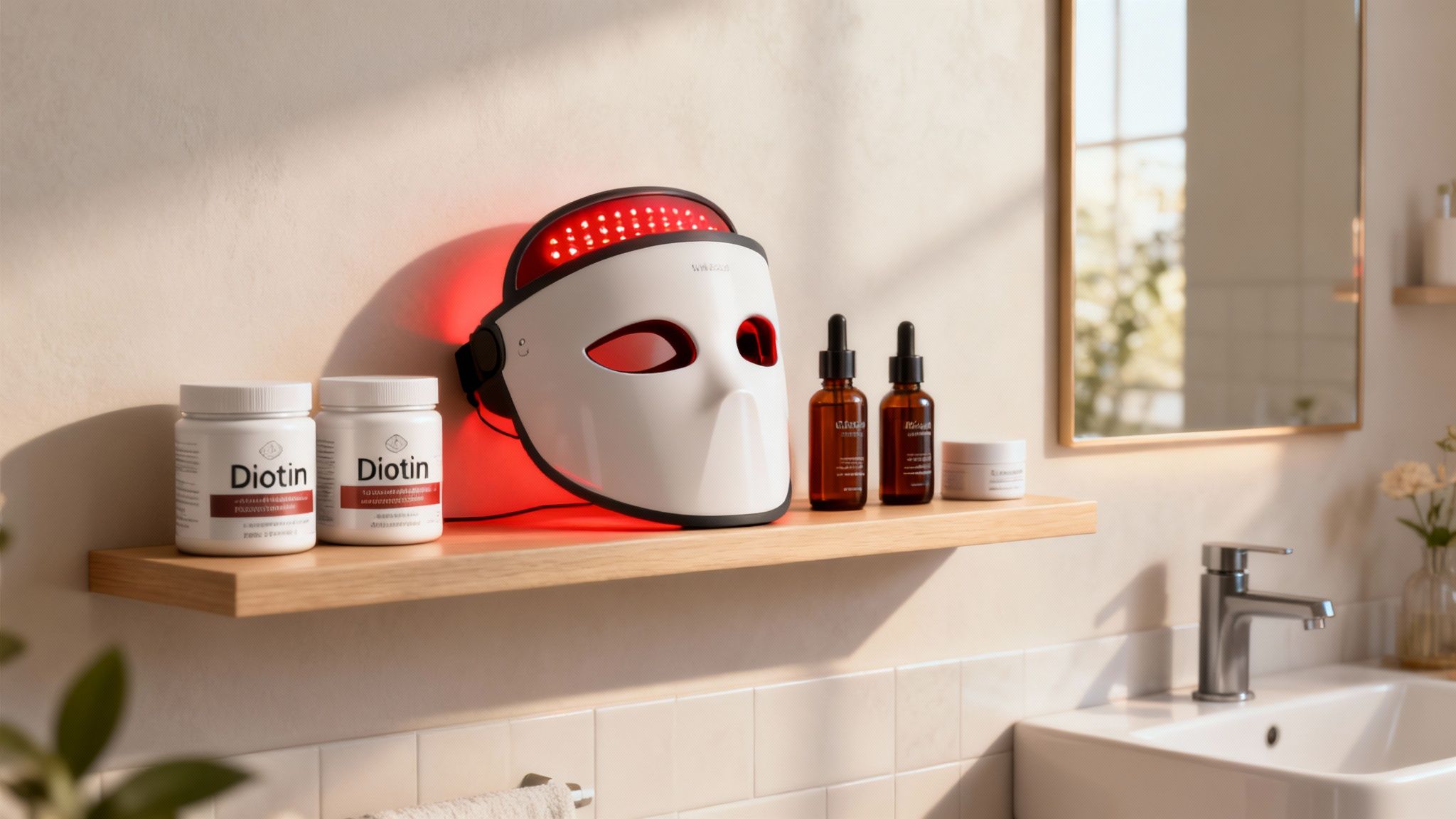
Finding a little too much hair in your brush or circling the shower drain is an unsettling feeling. But while it's often talked about as a "man's problem," it’s an experience a huge number of women go through, making the search for an effective hair loss treatment for women a deeply personal, and often urgent, journey. The most important thing to know is that you are absolutely not alone.
Why Female Hair Loss Is More Common Than You Think
That sinking feeling when you see strands left on your pillow can feel isolating, but the data tells a completely different story. Hair loss is a widespread issue for women, one that can take a real toll on self-esteem and emotional well-being. Simply recognizing just how common it is can be the first step toward finding a real solution and getting your confidence back.
This isn't just a hunch; it's a documented global trend. Data collected between 2017 and 2021 showed a sharp increase in women reporting hair loss worldwide. In mainland China, for instance, the percentage of women experiencing hair loss shot up from 31% in 2017 to 53% in 2021. We saw similar jumps in other major markets too, including the US (from 11% to 12%) and the UK (from 6% to 9%), proving this is a growing concern for women everywhere. You can dive deeper into the data and insights about this rising trend and its global impact.
Understanding the Key Types of Hair Loss
Not all hair loss is created equal. Just like different skin types need unique care routines, different kinds of hair loss have their own specific causes and, more importantly, their own treatment paths. Figuring out what type you're dealing with is the critical first step to getting on the right track.
Two of the most common forms women run into are:
- Female Pattern Hair Loss (FPHL): Also known as androgenetic alopecia, this is the number one cause. It usually shows up as a diffuse thinning over the crown or a widening part, while the front hairline stays put.
- Telogen Effluvium: This is a sudden, noticeable shedding of hair all at once. It’s almost always triggered by some kind of major physical or emotional stress—think childbirth, a serious illness, major surgery, or intense personal distress.
This infographic breaks down just how prevalent female hair loss is and which types are most common.

As you can see, by the time a woman reaches age 50, about one in three will experience some kind of hair loss, with female pattern hair loss being the culprit in most cases.
Moving Beyond Shock to Empowerment
The initial discovery of thinning hair can be alarming, to say the least. But that moment can also be a turning point—a catalyst for taking back control of your hair's health. The trick is to move past that initial wave of anxiety and start building a foundation of knowledge.
By understanding the landscape of female hair loss—its prevalence, common types, and underlying triggers—you empower yourself to seek targeted and effective solutions. This knowledge transforms anxiety into action.
This guide is designed to be your starting point. Here, you'll get the information you need to make sense of what's happening and to see that powerful, effective solutions are absolutely within reach. Armed with this knowledge, you can start your journey toward healthier, fuller hair with confidence.
Uncovering the Root Causes of Your Hair Thinning

Think of your hair’s growth cycle like a delicate garden. When the soil is rich and the conditions are just right, everything flourishes. But when something disrupts that balance—a change in seasons, a lack of nutrients, or unexpected stress—growth can stall. Your hair is no different.
Getting to the bottom of why your hair is thinning is the first real step toward finding a hair loss treatment for women that will actually work for you.
And if you feel like you're seeing more hair in your brush than ever, you're not alone. While we often associate hair loss with men, it's a huge issue for women. A recent study revealed that 23% of women between 18 and 65 reported their hair was thinning, compared to just 18% of men. You can learn more about these hair loss findings that are finally bringing this widespread concern to light.
So, what’s really going on? Let's break down the most common culprits.
The Hormonal Connection
Hormones are the powerful messengers that run the show behind the scenes, and that includes the intricate cycle of hair growth. When they fluctuate, the effects can show up right on your scalp. For so many women, addressing hormonal balance is a critical piece of the puzzle.
These shifts are often tied to major life events. Pregnancy, for instance, can trigger a period of lush, thick hair thanks to high estrogen, followed by significant shedding (telogen effluvium) postpartum as levels drop back to normal. Menopause is another key trigger, as declining estrogen can lead to a type of hair loss that looks a lot like male pattern baldness.
Genetics and Your Hair's Blueprint
Sometimes, the tendency for hair thinning is simply written into your DNA. Androgenetic alopecia, or female pattern hair loss, is the most common hereditary cause. This doesn't mean your hair will fall out overnight. Instead, it’s a gradual process where hair follicles shrink over time, producing finer and shorter strands until they eventually stop growing altogether.
If your mother, grandmother, or aunts experienced thinning hair, you might have a genetic predisposition. This doesn't seal your fate, but it does mean you’re a good candidate for proactive treatments designed to counteract this genetic blueprint.
Nutritional Gaps and Lifestyle Stressors
Your hair follicles are tiny but mighty factories, and they need a constant supply of vitamins and minerals to produce healthy hair. When your diet is lacking, your hair is often one of the first things to suffer.
Your hair is a barometer of your internal health. Deficiencies in key nutrients or high levels of chronic stress can directly interrupt the hair growth cycle, leading to noticeable thinning and shedding.
Deficiencies in these nutrients are common culprits:
- Iron: Low iron levels, or anemia, can essentially starve hair follicles of the oxygen they need to thrive.
- Vitamin D: Often called the "sunshine vitamin," it plays a crucial role in creating new follicles.
- Biotin and Zinc: These are the essential building blocks for producing keratin, the very protein that makes up your hair.
Beyond nutrition, chronic stress is a massive disruptor. High levels of the stress hormone cortisol can prematurely push a large number of hair follicles into the shedding phase, leading to diffuse thinning all over. This is exactly why managing stress through mindfulness, exercise, or other relaxation techniques is a vital part of any real hair wellness plan.
Understanding these triggers is your first tool for having a productive conversation with a specialist and finally finding a path forward. To make it clearer, here’s a quick summary of the primary factors at play.
Common Causes of Hair Loss in Women
This table summarizes the primary internal and external factors that can lead to female hair thinning and loss.
| Category | Specific Cause | How It Affects Hair |
|---|---|---|
| Hormonal | Menopause, Postpartum | Fluctuations in estrogen and androgens disrupt the growth cycle, often leading to increased shedding or thinning. |
| Genetic | Androgenetic Alopecia | Inherited sensitivity to hormones causes follicles to shrink over time, producing finer, shorter hairs. |
| Nutritional | Iron, Vitamin D, Zinc Deficiency | Lack of essential nutrients starves follicles, impairing their ability to produce strong, healthy hair. |
| Lifestyle | Chronic Stress (High Cortisol) | Pushes a large number of hair follicles prematurely into the "shedding" phase of the growth cycle. |
Pinpointing which of these might be affecting you is the key to choosing an effective, targeted treatment plan.
Exploring Professional Hair Restoration Treatments

When at-home remedies and supplements aren't delivering the results you want, turning to a medical professional is a powerful next step. The world of clinical hair loss treatments can seem intimidating, but understanding the main options demystifies the process. It helps you walk into a consultation feeling prepared and confident.
These treatments are backed by science and designed to target the biological mechanics behind hair thinning, offering a much stronger line of defense. And you're not alone in seeking them out.
The global hair loss industry, valued at around USD 37.84 billion in 2017, ballooned to USD 52.37 billion by 2022. Forecasts predict it could reach nearly USD 88.18 billion by 2030, with women becoming increasingly proactive about finding real solutions.
FDA-Approved Topical Treatments
For many, the most accessible and widely recognized starting point is Minoxidil, the only FDA-approved over-the-counter topical treatment for female pattern hair loss. Think of it as a wake-up call for sleepy hair follicles.
Minoxidil works by extending the anagen (growth) phase of the hair cycle while also boosting blood flow to the scalp. This one-two punch helps revitalize shrunken follicles, encouraging them to produce thicker, healthier strands over time.
- How It's Used: It typically comes in a 2% or 5% foam or liquid solution that you apply directly to your scalp once or twice a day.
- What to Expect: Patience is everything here. You might notice some initial shedding as old, weaker hairs make way for new growth. Real, noticeable results generally appear after three to six months of consistent use, with the best effects often seen around the one-year mark.
Prescription Medications for Hormonal Hair Loss
For a huge number of women, hair loss is directly linked to hormonal shifts—specifically, a heightened sensitivity to androgens (male hormones). When that’s the case, a dermatologist can prescribe oral medications to tackle the problem from the inside out.
Spironolactone is a common prescription used off-label for exactly this purpose. While it’s technically a diuretic, it also has the powerful side effect of blocking androgen receptors. This shields your hair follicles from the very hormones that cause them to shrink and stop producing healthy hair.
By getting to the hormonal root of the problem, prescription medications like Spironolactone can be a cornerstone of a successful hair restoration plan, especially when topical treatments alone just aren't cutting it.
Advanced In-Office Procedures
If you're looking for a more direct, hands-on approach, advanced clinical procedures can deliver some of the most promising results. These treatments use your body's own healing mechanisms to kickstart new hair growth.
One of the most popular and effective options is Platelet-Rich Plasma (PRP) therapy. The procedure is straightforward: a small amount of your own blood is drawn, spun in a centrifuge to separate and concentrate the platelets, and then this golden serum is injected directly into your scalp.
Think of PRP as a potent, all-natural fertilizer for your hair follicles. It’s packed with growth factors that signal dormant follicles to wake up, improve circulation to the scalp, and promote the production of stronger, thicker hair. And because it uses your own biological material, the risk of a negative reaction is virtually zero. If this sounds like a path you'd want to explore, you can learn more about the benefits of PRP for hair loss in our detailed guide.
Choosing a professional hair loss treatment is a big decision. By understanding how these options work, you can have a much more informed discussion with your doctor and land on a strategy that truly aligns with your specific needs, lifestyle, and hair goals.
Powerful At-Home Therapies and Hair Care Rituals

Real, lasting results aren't just built in a clinic. A consistent at-home routine is a fundamental part of any successful hair loss treatment for women, giving you the power to take proactive steps every single day. These rituals are the perfect complement to professional treatments, creating the ideal environment for healthy hair to flourish right from your own home.
Think of it as a two-pronged attack. We're combining smart technology for scalp stimulation, targeted nutrition for internal strength, and the right topical products to build a solid foundation. This strategy ensures you're supporting your hair follicles from both the inside and out.
Harnessing Light to Awaken Follicles
One of the most exciting tools you can bring into your home is Low-Level Light Therapy (LLLT). This isn't science fiction; it's technology that uses specific wavelengths of light to gently energize the cells inside your hair follicles, essentially waking them up from a dormant state. Imagine giving a weak plant the perfect dose of sunlight to spark new life. That’s LLLT for your hair.
It works by boosting circulation right at the scalp, delivering a fresh wave of oxygen and nutrients to the follicle's root. This process helps extend the hair's growth phase, encouraging the production of thicker, stronger strands over time.
A brilliant way to integrate this therapy is with multi-purpose devices built for both skin and scalp wellness. The Barb N.P. Facial Mask, for instance, is an excellent tool for this. Its red light setting is precisely the wavelength used in LLLT to stimulate scalp circulation and cellular activity.
What makes it a seamless addition to your routine?
- Complete Comfort: The mask is designed to sit comfortably on your face, allowing you to easily position it over your hairline and scalp without any awkward angles.
- Wireless Freedom: It's completely wireless, so you can use it while relaxing on the sofa or moving around the house. Consistency becomes effortless.
- Versatile Treatments: With three different light settings, it's a versatile device for your overall skin and scalp health, addressing everything from circulation to skin clarity.
Building Your Hair from the Inside Out
While technology stimulates from the outside, true hair health is built from within. Nutritional gaps are a common culprit behind thinning hair, making targeted supplements a non-negotiable part of at-home care. Your follicles are little protein-producing powerhouses, and they need a steady stream of vitamins and minerals to do their job properly.
Key nutrients that play a vital role in hair structure and growth include:
- Biotin: An essential B-vitamin for producing keratin, the very protein that makes up your hair.
- Iron: Crucial for producing hemoglobin, which carries oxygen to all your cells—including the ones that kickstart hair growth.
- Collagen: Provides the amino acid building blocks for keratin, helping strengthen the hair shaft and improve scalp elasticity. The Barb N.P. Collagen is formulated to provide a high-quality source of these essential proteins.
A nutrient-rich internal environment is the foundation for healthy hair. Supplements fill in the gaps your diet might miss, ensuring your follicles have all the raw materials they need to build strong, resilient hair.
For an easy and effective way to support hair growth and strength, consider adding a supplement like Hair, Skin, Nails Extra Strength Biotin Gummies to your daily ritual. These formulas pack key nutrients into a simple, easy-to-take format.
Creating a Scalp-First Hair Care Ritual
It's time to start treating your scalp with the same care and attention you give the skin on your face. A healthy scalp is clean, balanced, and free from the inflammation and buildup that can literally suffocate hair follicles and stop growth in its tracks.
A powerful at-home ritual doesn't have to be complicated. It just needs consistency.
- Use a Specialized Shampoo: Look for shampoos with ingredients like ketoconazole or saw palmetto, which help tackle the inflammation and hormonal factors that contribute to thinning.
- Apply a Scalp Serum: Serums are like potent treatments for your follicles, delivering concentrated active ingredients right where they're needed. Peptides, caffeine, and antioxidants can help boost circulation and protect against environmental stress.
- Gentle Scalp Massage: Just five minutes a day can make a world of difference. A daily massage manually boosts blood flow, eases scalp tension, and helps your topical products absorb more effectively.
By weaving these at-home therapies together—light technology, targeted supplements, and a dedicated scalp care ritual—you create a powerful, holistic system. This approach provides the comprehensive support your hair needs to thrive, turning your daily routine into a proactive treatment for stronger, fuller hair.
Building a Lifestyle That Supports Healthy Hair
Clinical treatments and at-home devices are incredible tools, but the real secret to sustainable, long-term hair health is addressing it from the inside out. Truly vibrant hair is built on a foundation of daily habits. By zeroing in on nutrition, stress management, and scalp care, you create the perfect internal environment for your hair to thrive.
These shifts aren’t just about hair—they elevate your entire well-being, delivering benefits that ripple far beyond your hairline.
Think of your body as the soil and your hair as the garden. Nurturing the soil is the only way to guarantee a healthy, vibrant bloom.
Fueling Your Follicles With a Hair-Friendly Diet
Your hair follicles are tiny, non-stop factories, and they need a constant supply of specific nutrients to build strong, resilient hair strands. A diet that’s missing key vitamins and minerals is one of the fastest ways to throw your hair growth cycle out of whack, leading directly to weaker hair and more shedding.
Every meal is an opportunity to give your follicles the raw materials they’re craving. Some of the most critical nutrients for hair include:
- Iron: This mineral is non-negotiable for producing hemoglobin, which carries oxygen right to your hair’s roots to fuel growth.
- Biotin: A powerhouse B-vitamin that’s essential for producing keratin, the very protein that makes up over 90% of your hair.
- Zinc: Plays a huge role in hair tissue growth and repair, helping to keep the oil glands around your follicles working just right.
- Protein: Since your hair is literally made of protein, getting enough in your diet is the first step to building strong strands.
For anyone looking to cover all their bases and fill in potential dietary gaps, supplements can be a fantastic safety net. You can learn more by checking out our guide on finding the best hair growth supplements that work.
To make it easier to build a hair-friendly plate, here’s a quick guide to the most important nutrients and where to find them.
Hair Growth Nutrients and Their Food Sources
| Nutrient | Role in Hair Health | Top Food Sources |
|---|---|---|
| Iron | Carries oxygen to hair roots, fueling cell growth. | Red meat, spinach, lentils, fortified cereals, oysters. |
| Biotin (B7) | Essential for keratin production, the protein hair is made of. | Eggs (yolk), almonds, salmon, sweet potatoes, avocados. |
| Zinc | Supports hair tissue growth and repair; keeps follicles healthy. | Oysters, beef, pumpkin seeds, chickpeas, cashews. |
| Vitamin C | Helps produce collagen and aids in iron absorption. | Citrus fruits, bell peppers, strawberries, broccoli. |
| Vitamin E | An antioxidant that reduces oxidative stress on the scalp. | Sunflower seeds, almonds, spinach, avocados. |
| Protein | The literal building block of every single hair strand. | Lean meats, poultry, fish, eggs, dairy, legumes, tofu. |
Focus on incorporating a variety of these foods into your daily meals to ensure your follicles are getting everything they need to perform at their best.
Mastering Stress to Prevent Shedding
Chronic stress is a known enemy of healthy hair. When you’re constantly wound up, your body floods with the hormone cortisol. This can shock a huge number of your hair follicles, pushing them prematurely into the shedding (telogen) phase. The result is a condition called telogen effluvium—a sudden, diffuse, and frustrating type of hair loss.
Managing your stress isn't just a mental health practice; it’s a critical part of any effective hair care plan. Simple, consistent habits can dramatically lower cortisol and protect your follicles from its damaging effects.
By actively managing your body's stress response, you directly protect your hair from the disruptive effects of cortisol. This makes mindfulness and exercise two of the most effective, non-invasive treatments for preventing stress-induced shedding.
Try weaving these simple techniques into your daily routine:
- Mindfulness and Meditation: Even just 10 minutes a day can help regulate your nervous system and slash cortisol levels.
- Regular Exercise: Moving your body—whether it’s walking, yoga, or cycling—boosts circulation to your scalp and releases endorphins, nature’s best stress relievers.
Redefining Scalp Care as Skincare
It’s time to start treating the skin on your head with the same care and attention you give the skin on your face. A healthy scalp—clean, balanced, and with great circulation—is the literal bedrock of strong hair growth. When product buildup, excess oil, and inflammation take over, they can clog follicles and stop them from doing their job.
Think of scalp care as a natural extension of your skincare routine. Regular cleansing, gentle exfoliation, and massage all work together to create the ideal environment for new hair to emerge.
Even a simple scalp massage for a few minutes each day can boost blood flow, delivering a fresh wave of oxygen and nutrients directly to your hair roots. This tiny act transforms a routine into a proactive treatment, ensuring your scalp is the perfect foundation for the healthy hair you’re working so hard to achieve.
Your Action Plan for Reclaiming Hair Confidence
Navigating the world of female hair loss can feel overwhelming, but a clear, actionable path is your first step toward reclaiming control. The most important thing to remember is that this is a journey, not an overnight race. The secret lies in blending expert advice with consistent, dedicated at-home care.
Think of your strategy as a two-pronged attack. First, you need to get to the root of the problem by identifying your unique triggers with a professional. Once you have a clear diagnosis, you can integrate their recommendations with powerful therapies you can do yourself.
Consistency is your greatest ally here. Whether you're using a prescription treatment or incorporating smart tools like the Barb N.P. LED Facial Mask, daily commitment is what drives results. This comfortable, wireless device with three light settings makes scalp stimulation an effortless part of your routine—no excuses.
By taking this proactive approach—combining medical guidance, dedicated home care, and positive lifestyle changes—you create a powerful system for managing hair loss. This empowers you to move forward with healthier hair and a renewed sense of self.
For more strategies on boosting volume and density, you can explore our detailed guide on how to thicken thinning hair. Remember, every consistent step you take is a move toward the fuller, healthier hair you deserve.
Your Questions About Hair Loss, Answered
Stepping into the world of hair loss treatments can feel overwhelming, and it's natural to have a lot of questions. Here, we're cutting through the noise to give you clear, straightforward answers to the concerns we hear most often.
When Should I See a Doctor for Hair Loss?
It’s time to call in a professional if you notice sudden, dramatic shedding, see visible bald patches, or experience any scalp discomfort like itching or pain. Think of it this way: while you can tend to your garden, a soil expert can tell you exactly which nutrients are missing. A dermatologist does the same for your scalp.
Getting a proper diagnosis is the critical first step. A doctor can run tests to rule out underlying issues like thyroid imbalances or nutritional deficiencies, which is the only way to find a hair loss treatment for women that will actually work for you.
How Does Light Therapy for Hair Actually Work?
This is one of our favorite at-home therapies. Low-Level Light Therapy (LLLT), or red light therapy, uses specific wavelengths of light to gently wake up your hair follicles. The light energy gets absorbed by the cells in your scalp, which helps boost circulation and nudge dormant follicles back into their active growth phase.
It’s like giving a sleepy houseplant the perfect dose of morning sun to encourage new leaves.
The real goal of LLLT is to energize the tiny cells responsible for producing hair. By improving blood flow and cellular activity right at the root, it helps follicles create thicker, stronger hair over time.
You can now get this technology in easy-to-use at-home devices. The Barb N.P. Facial Mask, for example, has a red light setting perfect for stimulating scalp circulation along the hairline. It’s a great option for integrating this therapy into your routine because it’s:
- Wireless, giving you total freedom to move around.
- Designed for a comfortable fit, so it's easy to position over your hairline.
- Equipped with three light settings for versatile skin and scalp treatments.
Can My Hair Grow Back After Thinning?
Yes, absolutely. For many types of hair loss, like the shedding that happens after a stressful event (telogen effluvium), your hair can grow back completely once the trigger is gone.
Even with genetic conditions like female pattern hair loss, which is chronic, the right treatments can effectively halt progression and help regrow a significant amount of hair. The key is consistency and targeting the root cause. Combining professional guidance with a dedicated at-home routine creates the perfect environment for regrowth, but patience is a must. Results are rarely overnight and often take several months to become noticeable.
At BotoxBarb, we believe in empowering you with both expert clinical treatments and the best at-home care to support your journey. Explore our curated selection of medical-grade hair solutions and book a consultation to create a personalized plan for reclaiming your hair confidence.

